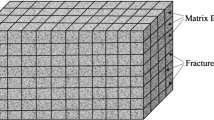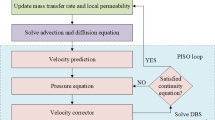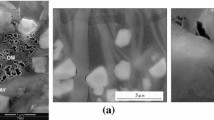Abstract
Change in pore pressure in chemically active rocks such as shale is caused by several mechanisms and numerous studies have been carried out to investigate these mechanisms. However, some important coupling terms or driving forces have been neglected in these studies due to simplifying assumptions. In this study, a hydro-chemo-thermo-electrical model based on finite element method is presented to investigate the change in pore pressure in shale formations resulted from thermal, hydraulic, chemical and electric potential gradients. The change in pore pressure is induced by hydraulic conduction, chemical, electrical and thermal osmotic flow. In order to solve the problem of ion transfer under the influence of an electrical field, the Nernst–Planck equation is used. In addition, ion advection is considered to investigate its possible effect on ion transfer for the range of shale permeability. All equations are derived based on the thermodynamics of irreversible processes in a discontinuous system. The numerical results are compared against existing and derived uncoupled analytical solutions and good agreement is observed. The numerical results showed that the ion transfer and pore pressure are considerably affected by the electric field in the vicinity of the wellbore. It was also found that advection can play a remarkable role in ion transfer in shale formations. It was further shown that the change in pore pressure in shale formation is characterized by the combined effect of hydraulic, chemical, thermal and electro osmotic flow.
Similar content being viewed by others
Abbreviations
- \({\mathop{C^{S}}\limits^-}\) :
-
Average solute mass fraction in formation
- \({\mathop{C^{D}}\limits^-}\) :
-
Average diluent mass fraction in formation
- C a :
-
Anions mass fractions
- C c :
-
Cations mass fractions
- C j :
-
Solute mass fraction of n chemical species
- c T :
-
Thermal conductivity
- C :
-
Specific heat capacity
- C m :
-
Average solute mass fraction in drilling fluid
- C f :
-
Average solute mass fraction in pore fluid
- D j :
-
Solute diffusion coefficient of each chemical species
- \({D_{j}^{T}}\) :
-
Coefficient of thermal diffusion of each chemical species
- E :
-
Electric potential
- E m :
-
Average electric potential of drilling fluid
- E f :
-
Average electric potential of pore fluid
- F :
-
Faraday’s constant (96,485 C/mol electrons)
- k :
-
Permeability
- K T :
-
Thermal osmosis coefficient
- K E :
-
Electrical osmosis coefficient
- K f :
-
Fluid bulk module
- M S :
-
Molar mass of the solute
- M j :
-
Molar mass of j chemical species
- n :
-
Number of nodes
- N P :
-
Pressure shape functions
- N E :
-
Electric potential shape functions
- N T :
-
Temperature shape functions
- \({N_{\rm C}^{S}}\) :
-
Mass fraction shape functions
- p :
-
Pressure
- R :
-
Universal gas constant
- t :
-
Time
- T :
-
Temperature
- T a :
-
Absolute temperature
- T m :
-
Average temperature of drilling fluid
- T f :
-
Average temperature of pore fluid
- z j :
-
Charge of j chemical species
- η :
-
Coefficient of solute retardation
- μ :
-
Viscosity
- \({\mathop {\rho _{\rm f}}\limits^- }\) :
-
Average fluid density
- ρ :
-
Fluid density
- \({\phi}\) :
-
Porosity
- \({\mathfrak{R}}\) :
-
Standard solute reflection coefficient
- σ ee :
-
The effective electric conductivity of porous media
- C IP :
-
The electrical capacitance per unit volume
- σ et :
-
The coefficient of thermo-electricity (Seebeck effect)
References
Acar Y.B., Gale R.J., Alshawabkeh A.N., Marks R.E., Puppala S., Bricka M., Parker R.: Electrokinetic remediation: basics and technology status. J. Hazard. Mater. 40(2), 117–137 (1995)
Alshawabkeh A.N., Acar Y.B.: Electrokinetic remediation. II: theoretical model. J. Geotech. Eng. 122(3), 186–196 (1996)
Bader S., Kooi H.: Modelling of solute and water transport in semi-permeable clay membranes: comparison with experiments. Adv. Water Res. 28(3), 203–214 (2005)
Bear J.: Dynamics of fluids in porous media. Dover, New york (1988)
Bear J., Bachmat Y.: Theory and application of transport in porous media, vol. 4. Kluwer Academic Publishers, Dordrecht (1991)
Chenevert M.E.: Shale control with balanced-activity oil-continuous muds. SPE J. Petroleum Technol. 22(10), 1309–1316 (1970). doi:10.2118/2559-pa
Cooper GA, Roy S (1994) Prevention of bit balling by electro-osmosis. Paper presented at the SPE western regional meeting, Long Beach, Mar 23 1994
Detournay E., Cheng A.H.D.: Poroelastic response of a borehole in a non-hydrostatic stress field. Int. J. Rock Mech. Min. Sci. & Geomech Abstract 25(3), 171–182 (1988)
Ghassemi A., Diek A.: Porothermoelasticity for swelling shales. J. Petroleum Sci. Eng. 34(1-4), 123–135 (2002)
Ghassemi A., Diek A.: Linear chemo-poroelasticity for swelling shales: theory and application. J. Petroleum Sc. Eng. 38(3-4), 199–212 (2003)
Ghassemi A., Tao Q., Diek A.: Influence of coupled chemo-poro-thermoelastic processes on pore pressure and stress distributions around a wellbore in swelling shale. J. Petroleum Sci. Eng. 67(1-2), 57–64 (2009)
Haase R.: Thermodynamics of irreversible processes. Dover, New York (1990)
Hanshaw B.B., Zen E.-A.: Osmotic Equilibrium and Overthrust Faulting. Geol. Soc. Am. Bull. 76(12), 1379–1385 (1965). doi:10.1130/0016-7606(1965)76[1379:oeaof]2.0.co;2
Hariharan PR, Cooper GA, Hale AH (1998) Bit balling reduction by electro-osmosis while drilling shale using a model BHA (Bottom Hole Assembly). Paper presented at the IADC/SPE drilling conference, Dallas, 03 Feb 1998
Heidug W.K.: A thermodynamic theory of fluid-infilterated porous media undergoing large deformations and change of phase. Brown University, Providence (1985)
Heidug W.K., Wong S.-W.: Hydration Swelling of Water-Absorbing Rocks: A Contitutive Model. Int. J. Numer. Anal. Methods Geomech. 20(6), 403–430 (1996)
Kooi H., Garavito A.M., Bader S.: Numerical modelling of chemical osmosis and ultrafiltrationacross clay formations. J. Geochem. Explor. 78(79), 333–336 (2003)
Lal M (1999) Shale stability: drilling fluid interaction and shale strength. Paper presented at the SPE Asia pacific oil and gas conference and exhibition, Jakarta, Apr 20 1999
Lewis R.W., Nithiarasu P., Seethararmu K.N.: Fundamentals of the finite element method for heat and fluid flow, p. 356. Wiley, Hoboken (2004)
Moyne C., Murad M.: A two-scale model for coupled electro-chemo-mechanical phenomena and onsagers reciprocity relations in expansive clays: I homogenization analysis. Transp. Porous Med. 62, 333–380 (2006)
Narasimhan B., Sri Ranjan R.: Electrokinetic barrier to prevent subsurface contaminant migration: theoretical model development and validation. J. Contam. Hydrol. 42(1), 1–17 (2000)
Onsager L.: Reciprocal relations in irreversible processes. I. Phys. Rev. 37(4), 405–426 (1931)
Revil A, Leroy P (2001) Hydroelectric coupling in a clayey material. Geophys. Res. Lett. 28. doi:10.1029/2000gl012268
Revil A, Pessel M (2002) Electroosmotic flow and the validity of the classical Darcy equation in silty shales. Geophys. Res. Lett. 29. doi:10.1029/2001gl013480
Roshan H, Rahman SS (2010) A fully coupled chemo-poroelastic analysis of pore pressure and stress distribution around a wellbore in water active rocks. Rock Mech. Rock Engng. doi:10.1007/s00603-010-0104-7
Roy S., Cooper G.A.: Prevention of bit balling in shales—preliminary results. SPE Drill. Complet. 8(3), 195–200 (1993). doi:10.2118/23870-pa
Soler J.M.: The effect of coupled transport phenomena in the Opalinus Clay and implications for radionuclide transport. J. Contam. Hydrol. 53(1-2), 63–84 (2001)
Srivastava R.C., Jain A.K., Upadhyay S.K.: Electro-osmosis of water through a collodion membrane. J. Non-Equilib. Thermodyn. 3(2), 83–92 (2009). doi:10.1515/jnet.1978.3.2.83
van Oort E., Hale A.H., Mody F.K., Roy S.: Transport in shales and the design of improved water-based shale drilling fluids. SPE Drill. Complet. 11(3), 137–146 (1996). doi:10.2118/28309-pa
Wang M., Chen S.: Electroosmosis in homogeneously charged micro- and nanoscale random porous media. J. Colloid and Interface Sci. 314(1), 264–273 (2007). doi:10.1016/j.jcis.2007.05.043
Wang M., Kang Q.: Modeling electrokinetic flows in microchannels using coupled lattice Boltzmann methods. J. Computational Phys. 229(3), 728–744 (2010). doi:10.1016/j.jcp.2009.10.006
Wang M., Revil A.: Electrochemical charge of silica surfaces at high ionic strength in narrow channels. J. Colloid and Interface Sci. 343(1), 381–386 (2010). doi:10.1016/j.jcis.2009.11.039
Wang Y., Dusseault M.B.: A coupled conductive-convective thermo-poroelastic solution and implications for wellbore stability. J. Petroleum Sci. Eng. 38(3-4), 187–198 (2003)
Yeung A.T.: Coupled flow equations for water, electricity and ionic contaminants through clayey soils under hydraulic, electrical and chemical gradients. J. Non-Equilib. Thermodyn. 15(3), 247–268 (2009). doi:10.1515/jnet.1990.15.3.247
Zienkiewicz O.C., Taylor R.L.: The finite element method—basic formulation and linear problems, vol 1. 5th edn. Butterworth-Heinemann, Oxford (2000)
Author information
Authors and Affiliations
Corresponding author
Rights and permissions
About this article
Cite this article
Roshan, H., Aghighi, M.A. Analysis of Pore Pressure Distribution in Shale Formations under Hydraulic, Chemical, Thermal and Electrical Interactions. Transp Porous Med 92, 61–81 (2012). https://doi.org/10.1007/s11242-011-9891-x
Received:
Accepted:
Published:
Issue Date:
DOI: https://doi.org/10.1007/s11242-011-9891-x




